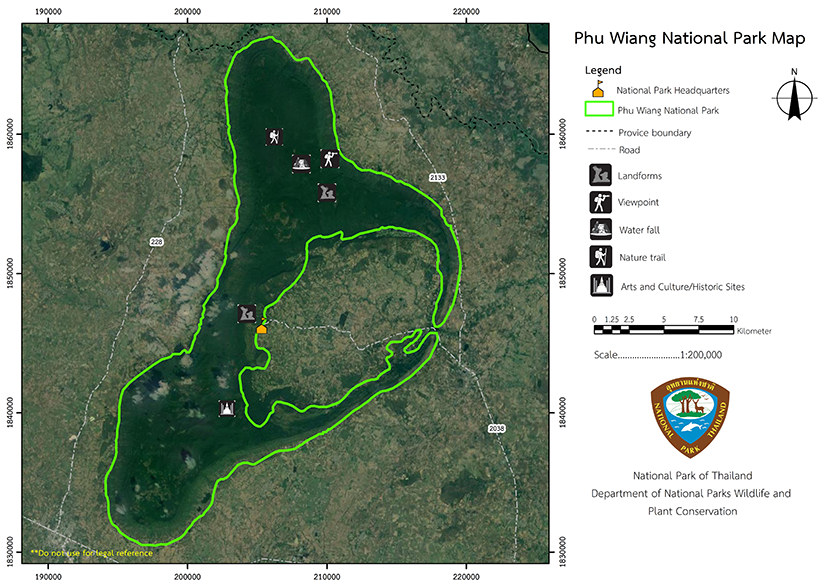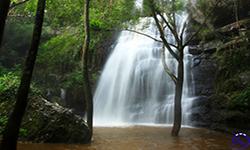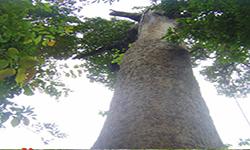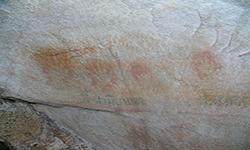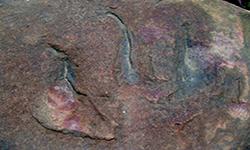Phu Wiang National Park
Contact Location : Phu Wiang National Park, Nai Mueang Sub-district, Wiang Kao District, Khon Kaen Province 40150
Telephone Number : (+66) 4343 8333
Email : Phuwiangn71@hotmail.com
Facebook : Phu Wiang National Park
Information
Phu Wiang is the name of the old district of Khon Kaen Province, and is also the name of the mountain range, for whichthere is currently a royal decree designating the Phu Wiang forest area as a national park,located in the areas of Phu Wiang District, Si Chomphu District, Chum Phae District, Wiang Kao District, and Nong Na Kham District in Khon Kaen Province,
Background
There is evidence that the Phu Wiang Forest used to be a civilized ancient community since about thousand years ago. Ancient human bones, bronze metal tools, and a reclining Buddha image of the Dvaravati period as well as including prehistoric color paintings have been discovered in the excavation at the cave (Tham Lueb Ngern) in the Phu Wiang Mountain range. In addition, around 1976, footprints and fossils of dinosaurs and fossils nearly 200 million years old were discovered, which Her Royal Highness Princess Maha Chakri Sirindhorn, was interested in and came to visit on November 3, 1989.
In the past, Phu Wiang Forest was declared as a National Reserved Forest according to Ministerial Regulation No. 64, B.E. 2508, dated June 24, 1965, logging in the area was started under the conditions of the government and the Khon Kaen Logging Company was a concessionaire. General Han Sinanon, Minister of Agriculture and Cooperatives, went on the inspection tour and flew to inspect the forest conditions on May 16, 1987. It was found that some forests were in good condition. Therefore, he considered to preserve the perfect forest as a national park and assigned the officers to inspect and monitor logging concessions in both the areas where the logging was finished and where logging is in progress. The results of an inspection by a group of officials from ISOC Region 2 and the forestry officers of Khon Kaen Province on May 23, 1987 showed that logging in the concession forest of Phu Wiang Project (Kho Ko 2) Section 7, Plot 21 by Khon Kaen Forestry Company has been carried out in accordance with the regulations, policies, and conditions of the concession. and left some reserved trees.
According to the report of Khon Kaen Province No. Kho Ko 0009/21641 dated June 3, 1987, the Minister of Agriculture and Cooperatives issued an order dated June 16, 1987, for the Royal Forest Department to consider establishing a Phu Wiang National Park.
The National Park Division had a letter No. Ko So. 0713/713 dated July 20, 1987, which is proposed to the Royal Forest Department with an order No. 1162/2530 dated July 22, 1987, for Mr. Udom Yokchawee, Forest Officer 4, to conduct a preliminary survey of the forest, Phu Wiang and the nearby forest, to be designated as a national park. It has been reported, according to the letter Ko So 0713/special dated September 11, 1987, that the forest area and nearby areas have many tourist attractions and natural landmarks and have historical sources suitable for being established as a national park.
The National Park Division had a letter No. Ko So 0713/1064 dated October 7, 1987, proposing to the Royal Forest Department an order 1643/2530 dated October 8, 1987, for Mr. Udomsak Suphanpong, a Forestry Officer 4, to proceed the establishment of the areas of Phu Wiang forest and nearby forests in Phu Wiang district, Khon Kaen Province as a National Park. Later on, the Phu Wiang National Parksubmitted a letter No. Ko So 0713 (Pho Wo.)/40 dated April 2, 1988, which reported the survey results to designate the areas for the National Park Division Defense to consider establishing as a national park.
The Royal Forest Department has presented to the National Parks Board which rosolved in the meeting, No. 3/2532, dated October 3, 1989 agreed to designate the area as a national park. The royal decree specified the area of Phu Wiang forest land in Kut That, Nai Mueang, Ban Khok, Khao Noi, Khanuan, Ban Ruea, Mueang Kao Phatthana, Song Puea and Na Chum Saeng Sub-district, Phu Wiang District, Wang Perm, Si Suk and Na Chan Sub-district, Si Chomphu District, and Wang Hin Lat, Nong Sao Lao, Nong Phai, and Khua Rieng Sub-district, Chum Phae district, Khon Kaen Province, approximately 203,125 rai or 325 square kilometers, to be a National Park, according to the announcement in the Government Gazette, Volume 108, Part 215, dated December 8, 1991.
it is the 71st National Park of Thailand.
Note : After paying the entrance fee to the National Park, please carry the receipt for inspection.
203125.00 rai (325 square kilometers)
|
|
|
||
|
|
|
||
|
|
|
||
Nature trails ⇔ Trekking ⇔ Visit Waterfall ⇔ Cave exploration/Geological condition ⇔ Forest viewpoint ⇔ Observe flowers/plant ⇔ History and culture watching ⇔ Stargazing ⇔ Mountain biking ⇔ Take a photo/Video
Welfare shop : 08.00 - 17:00 hrs.
Mobile phone signal :
National Park Headquarters area: AIS, TRUE, DTAC
|
|
The topography of Phu Wiang National Park generally is enclosed within the two circles of mountain ranges, and in the middle there is a large basin, resembling a pan, which features a flat and undulating terrain. The area surrounding the basin is a mountain range which is angled towards the center of the basin. It consists of mountains ranging from moderately to highly steep slopes. The outermost mountain range has a peak of 844 meters above mean sea level. In the southwestern part of the area and the inner mountain range, the highest peak is 470 meters above mean sea level. The northern area of the inner mountain range is the source of the dinosaur fossils. Whereas the lowest level of the foothills is at 210 meters above mean sea level.
|
|
Phu Wiang National Park is influenced by the southeast monsoon and can be divided into 3 seasons as follows: Summer runs from March to April, the highest average temperature in April is 36.5 degree Celsius. The rainy season runs from May to October, the average annual rainfall is 1,199 mm. Winter, between November-February, the lowest average temperature of December is 16.6 degrees Celsius
|
|
|
|
Forest conditions in Phu Wiang National Park can be divided into 3 types: dry evergreen forest, which has the largest area, followed by deciduous dipterocarp forest and mixed deciduous forest. Most of the dry evergreen forests are scattered in the northern part of the national park area and the areas around the Istreams. The important plants are Hopea ferrea Laness, Dalbergia oliveri, Dalbergia cochinchinensis, Tetrameles nudiflora, Irvingia malayana, Afzelia xylocarpa, Dialium cochinchinense, Korlan, Sterculia guttata Roxb., Canango latifolia, etc. Undergrowth plants and epiphytic plants include Crape Ginger (Costus speciosus), Dracaena cochinchinensis, Curcuma alismatifolia, Curcuma parviflora, Platycerium holttumiide, Dendrobium secundum, Rhynchostylis coelestis, Habenaria dentata, and Phaius mishmensis, etc. Deciduous dipterocarp forest covers the areas around the foothills which are lower than the area of dry evergreen forest. It is scattered around Phu Pratu Tee Ma and inner mountains and the foothills of outer mountains which are part of the Phu Wiang Mountain range. The important plants include Dipterocarpus intricatus Dyer, Hairy Keruing, Dipterocarpus tuberculatus Roxb., Burma Sal, Shorea siamensis, Morinda coreia,Alangium indochinense, ., Myrobalan wood Vitex pinnata, etc. The undergrowth plants include Crape ginger, Arundinaria pusilia, Jasminum adenophyllum, Kaempferia roscoeana, Curcuma sessilis, Selaginella argentea and Adiantum latifolium and so on. A mixed deciduous forest is located at the boundary between a dry evergreen forest and a deciduous dipterocarp forest. Some part of it is scattered in the deciduous dipterocarp forest, and some is scattered around Phu Pratu Ti Ma , and the outer foothills of Phu Wiang Mountains. Important plants are Burma Padauk, Thai ฺBungor, Lagerstroemia calyculata, Crown Flower, Terminalia elliptica, Indian Coral Tree, Stereospermum neuranthum, and Vitex pinnata, etc. The wild animals living in the Phu Wiang forest include wild boars, foxes, macaques, Asian palm Civets, Burmese Hare, Finlayson's Squirrel, Indochinese ground Squirrel , Phayre's flying Squirrel, Northern Treeshrew, Flying Squirrels, Wrinkled-lipped Bat, Roof Rat , Polynesian Rat , Little Grebe, Lesser whistling-duck , Black-winged Kite, Shikra , Red Junglefowl, Chinese Francolin, Barred Buttonquail , White-breasted Waterhen , Red-wattled Lapwing, Thick-billed Green-pigeon, Rock Pigeon, Red Turtle-dove, Red-breasted Parakeet, Green-billed Malkoha, Greater Coucal , Collared Scops-owl, Asian barred Owlet, Indochinese Roller, Lineated Barbet, Asian Palm Swift, Barn Swallow, Black-capped Bulbul , Black Drongo , Pin-Striped Tit Babbler, Grey-breasted Prinia , Oriental Magpie Robin, Common Myna, Olive-backed Sunbird , Flat-tailed house Gecko , Tokay, Red-head Lizard, Butterfly Lizards , Bronze Grass Skink, East Indian brown Mabuya, King Cobra, Asian Common Toad, Puddle Frog, Tigger Frog, Dark-sided Frog , Chinese Edible Frog, Rice Field Frog, Common Tree Frog, Median-striped Bullfrog, Bubble Frog, Ornate narrow-mouthed Frog, etc. There are also many freshwater fish living in natural water sources in Phu Wiang National Park such as Channa striata, Batrachian walking catfish, Climbing Perch, Macrognathus siamensis, Swamp Eel, Lepidocephalichthys berdmorei, Striped Tiger Nandid, Flying Barb , Marbled Sleeper, Long-fatty Finned Mystus, Hemibagrus nemurus, etc. |
How to get there by car :
From Khon Kaen: Take National Highway No. 12 (Khon Kaen-Chum Phae) through Ban Fang and Nong Ruea District, heading fora junction in Phu Wiang District, a distance of about 48 kilometers, then turn onto Provincial Route No. 2038 for about 38 kilometers, and finally reach Phu Wiang National Park. Or take a public bus from Khon Kaen to Phu Wiang District with the distance of about 68 kilometers, and then take a rickshaw taxi from Phu Wiang District to Phu WiaIational Park with the distance of about 18 kilometers.
- Phu Wiang National Park Ranger Station No. 1 (Pak Chong)
- Phu Wiang National Park Ranger Station 2 (Hua Phu Chon)
- Phu Wiang National Park Ranger Station No. 3 (Phu Nokyung)
- Phu Wiang National Park Ranger Station No. 4 (Pak Huai Fang)
- Forest Protection Kho Ko No. 2 (Phu Wiang)
- Forest Protection Kho Ko No. 7 (Huai Sai Khao)
- Watershed Management Unit of Phu Wiang
- Tat Fa Checkpoint
- Khon Kaen Forest Fire Control, Chum Phae District, Khon Kaen Province
-

